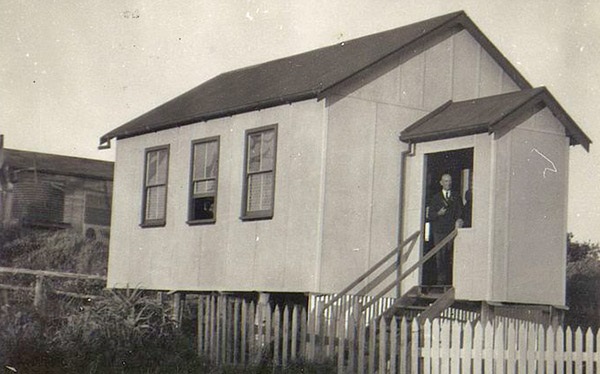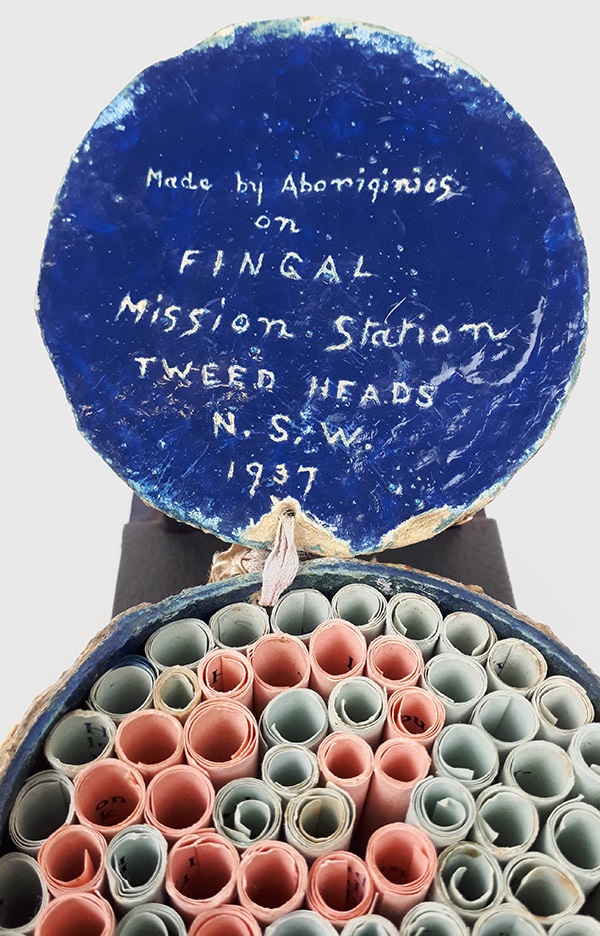Shellwork - Fingal Mission
 Fingal Mission, C.1946. TRM Collection TH2008.3.2.
Fingal Mission, C.1946. TRM Collection TH2008.3.2.The Fingal Mission was started by evangelist preacher, Leslie Ogilvie, in 1919. He originally planned to stay only three months at Fingal, a stop on his way from Sydney to Brisbane, however he stayed on permanently.
Leslie erected a large tent at Fingal and it was reported to be well visited by a large part of the community. He states that although “60 native and Islanders” professed conversion, “there has been some who were very manifestly not in sympathy”
 Detail of the inscription inside the lid of the Shellwork Promise Box made at Fingal Mission Station, 1937.
Detail of the inscription inside the lid of the Shellwork Promise Box made at Fingal Mission Station, 1937.After a storm knocked the tent to the ground, and no money could be found to replace it, the question arose as to the desirability of having a permanent building at Fingal for meeting purposes. This was considered “prayerfully” and the answer seemed to be “go ahead”. An application was made to the Lands Department for a block of land on which to erect a building. The Department granted the block the tent had sat on, a permissive occupancy lease at 10 shillings a year.
It is a mystery as to where the building funds came from, however Leslie mentioned he was receiving money from unknown individuals scattered through the Commonwealth and New Zealand. The building was finished in time to hold an Easter meeting in 1920; at this meeting five recent converts were baptised in the Tweed River. The Easter meetings at Fingal became very popular, and are still well attended in 2019. Leslie was joined in his mission work on the reserve by sisters Nina Eipper and Marion Rennie, and a small cottage was built to accommodate them. Pastor Ogilvie secured a lease for the Fingal lighthouse keeper’s quarters and remained in charge of the mission until his death in March 1927.
Various white missionaries were then sent to Fingal until the late 1940s; since then prominent Fingal families have filled formal roles in the Mission on and off throughout its history. The church is now known as the Aboriginal and Islander Christian Fellowship.
Shellwork Promise Box
This box decorated with shells is marked as being made by Aboriginal women at Fingal in 1937. It contains numerous paper scrolls, printed with individual prayers, and is known as a promise box. Shell work souvenirs like this one may have been made by local members of the Church as a source of income or to raise funds for the Mission itself.
Shells have been used by coastal Aboriginal communities for generations as tools, jewellery, and art. This type of souvenir shell work you see on this box has become a contemporary Aboriginal cultural practice.
It is documented that missionaries around Australia encouraged shellware souvenirs by Aboriginal women, both as a means of supporting themselves financially, and as an example of a mission’s success. Many residents of Fingal still make shellware today.
Shellwork Promise Box from Fingal mission. Donated by Rhys Davies. TRM Collection MUS2011.12